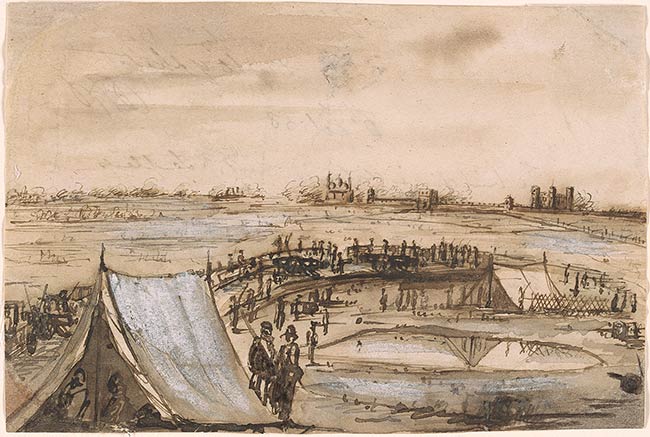
As a correspondent in the Crimean War, Guys made his mark through swift drawings composed at the front and sent for publication in French and British newspapers. One of these caught the eye of the art critic Charles Baudelaire, who was an important supporter of Guys' career.
Guys had traveled with the French army in 1854-55. The French troops supported the Ottoman Empire and allied with England and Sardinia-Piedmont against Russia. Guys personally witnessed the battles of Inkerman (Ukraine) and Balaklava (Sevastopol; Ukraine, under Russian administration since 2014), a conflict that saw the infamous Charge of the Light Brigade memorialized by Tennyson's poem.
The site depicted in the Morgan's drawing cannot be identified with certainty, but the two tents and the standing soldiers with artillery suggest a military encampment. The vague demarcation of figures in pen and brown ink, with a flurry of activity in the middle ground, resembles Guys' sketch of the harbor of Kamiesch on the Crimean peninsula, also from his Crimean War travels (Musée des Arts Décoratifs, Paris; inv. 34706). Guys' drawing also reflects similar topography and encampments found in Roger Fenton's photographs of the Crimean conflict made for publisher Thomas Agnew & Sons, London.
A difficult-to-decipher inscription in English is on the verso, suggesting that Guys' drawing was sent to a London newspaper. The remnants of two wax seals indicate the sheet was dispatched via post to the west.
Inscribed on verso in pen and brown ink, “Left [?] picket / fortified garden of Messr. Baylis / to right of sketch / [signed with paraph] / 6h Velz 58 / The building in distance to left of Temple is / called “The Yellow House” where the rebels / advanced B..tteries are from. Which they pitch / their shot [...] of the daily.”
McCrindle, Joseph F., former owner.
(Pierre Duflo, Constantin Guys, fou de dessin, grand reporter, 1802-1892. Paris, 1988, pp. 218-219).
